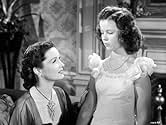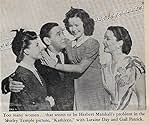Kathleen is a 12 year old who lives in a big house with a nanny, a butler, maids, no mother and a father who is working most of the time. She dreams of a family with a mother, father and her... Read allKathleen is a 12 year old who lives in a big house with a nanny, a butler, maids, no mother and a father who is working most of the time. She dreams of a family with a mother, father and her, and tells everyone that she has such a family. Because of this story, she cannot invite ... Read allKathleen is a 12 year old who lives in a big house with a nanny, a butler, maids, no mother and a father who is working most of the time. She dreams of a family with a mother, father and her, and tells everyone that she has such a family. Because of this story, she cannot invite any friends over as they will see that it is not true. Kathleen and her nanny, Mrs. Farrel... Read all
- Director
- Writers
- Stars
- Awards
- 2 wins total
- Miss Bewley
- (scenes deleted)
- Woman Customer at Shoner's Store
- (uncredited)
- Director
- Writers
- All cast & crew
- Production, box office & more at IMDbPro
Featured reviews
Kathleen Davis (Shirley Temple), is a 12-year-old girl whose mother died at the time of her birth. She lives in a luxurious home surrounded by servants who have looked after her more than her father, John Staunton Davis (Herbert Marshall), who is more away on business trips than spending quality time with his daughter. Kathleen has a strict governess, Mrs. Farrell (Nella Walker), whom she hates. Her only true friend happens to be Mr. Schonet (Felix Bressart), an elderly antique dealer who knows the truth behind Kathleen's imaginary friend, the girl on the hill, whose life echoes that of her own unhappy existence. Further complications ensue when Mr. Davis returns home with Lorraine Bennett (Gail Patrick), his female companion. Though unaware of her father's wedding plans to Miss Bennett, Kathleen takes an immediate dislike to her anyhow. Because of her strong dislike for Mrs. Farrell, Lorraine suggests Kathleen be examined by a child specialist. Doctor Montagu Foster (Lloyd Corrigan) finds nothing wrong with Kathleen but suggests Mrs. Farrell be dismissed and substituted by Doctor A. Martha Kent (Laraine Day), a child psychologist, who could remain with her until September before Kathleen is to be sent away to boarding school. At first Kathleen dislikes the young and down-to-earth lady doctor, but in time, grows fond of her enough to call her "Angel," based on her first name, Angela. While Kathleen hopes for Angela to become her father's new wife, she faces further disappointments when she learns of her father's upcoming wedding plans and extensive honeymoon trip with Lorraine, and having Angela cancel her proposed trip to South America to fill in for the responsibility actually intended for her neglectful father. Others in the cast include: Guy Bellis (Jarvis, the butler); Wade Boteler (The Policeman); and Joe Yule (The Sign Painter).
Though the plot for KATHLEEN could have been a Temple vehicle for 20th Century-Fox during her teenage years, this new MGM edition resumes the traditional Temple format originated by her own studio, that of a daughter of a single parent or an orphan. Temple even gets to have one song number, "Around the Corner," performed during her dream sequence rather than being part of the plot. Now a teenager and no longer a cute little child with the blondish curls, Temple's physical appearance gets reinvented through her darker and longer 1940s hairstyle along with her more mature speaking voice of a teenager. Being the only child for its entire 88 minutes, it would have been interesting had KATHLEEN been slightly altered by having two Temples for the price of one playing twin sisters scheming to get their father to realize his marriage to a woman they dislike would be a mistake. This idea was later put to good use for the Walt Disney classic, THE PARENT TRAP (1961) starring Hayley Mills playing the twin sisters. Having Temple in a dual role might have been too costly and time consuming for a standard movie project, yet might have been more pleasing for Temple fans.
As it stands, KATHLEEN is satisfactory entertainment with moral lesson learned by a father who lets others raise his daughter, who's a stranger to him, rather than by himself. Laraine Day is good as the pretty doctor who fills in as Kathleen's pretend older sister while Felix Bressart gives a likable performance as an elderly grandfather type to Kathleen. Gail Patrick stands out in her "other woman" role she's been doing quite often in other films around this time. As much as Herbert Marshall and Laraine Day do their parts well, it's interesting that in their previous pairing in Alfred Hitchcock's FOREIGN CORRESPONDENT (United Artists, 1940) they were cast together playing father and daughter. Though MGM never acquired further services from Temple, the studio would soon get a child star of its own, Margaret O'Brien, the Shirley Temple of the 1940s.
Unlike Temple's films for 20th Century-Fox, KATHLEEN was never distributed to video cassette nor, though currently available on DVD. It was never even part of Shirley Temple film festivals, but did get some exposure during the after midnight hours on the "late-late show" during the 1970s. KATHLEEN often plays on Turner Classic Movies cable channel, the home of the MGM film library. (**1/2)
All child actors must eventually face uncertainty when they outgrow the young roles that made them successful. Shirley Temple was beyond successful as a child actress, capturing the hearts of moviegoers for years. When she became too old for the "Good Ship Lollipop", would she be able to transition successfully into teen roles and adult roles?
In 'Kathleen", Shirley is 13 years old. The drama of this film is similar to dramatic scenes she had previously played as a child, but viewers expect more from older performers. In "Kathleen" she portrays angst and outrage, but her performance is too childlike, which impacts the early scenes especially. In a few years, she would be better equipped to emote with greater depth. In 1947's "That Hagen Girl", for example, she adeptly portrays a troubled teen beset with a haunting past who is the target of an entire town. 1949's "A Kiss for Corliss" (A comedy with David Niven) is effectively the end of her film career, so she used her newfound skills only sparingly.
Watch for Laraine Day and Gail Patrick, who face off over Kathleen's well-being and the girl's father, played by Herbert Marshall. All of them acquit themselves well. Day, remarkably, is only 8 years old than Shirley, but convincingly plays a professional woman who possesses authority and confidence.
One final note: this film was released soon after the attack on Pearl Harbor. I can only wonder what effect that had on attendance and the public's willingness to be entertained. The nation was in shock and dealing with important matters that completely altered its way of life. A determined response to aggression, and fears about worldwide aggression, were paramount. Still, the nation would learn to use cinema to channel its patriotic fervor and, conversely, to escape harsh realities.
Shirley Temple is having trouble growing into her terrible teens. It's a tough thing to have an icon change in front of your eyes. That's the difficulty faced by an audience of her era. She's also stuck using the same acting tricks that had worked so well as a child actor. While it looks cute as a child, it looks like sentimental cloying as she gets older. I do have an issue with the dream dance sequence with full grown men. It has different meaning as she grows into a young woman. The other big issue is the lack of chemistry between the father and Dr. Kent. It's not enough for Lorraine to be a sneaky gold-digger. This has all the ingredients but the mixture is barely passable.
I think the main problem is that Shirley looks too old. Virginia would have been more believable (with the braids, which were becoming a cliché by this point in her career). However, it certainly would have worked best with a young Margaret O'Brien. It really had to be someone very tiny and fragile looking, who desperately needed a new mommy to look after her. Laraine Day is fine in her role, Nella Walker as a battle-axe is very good, and I find Felix Bressart to be as charming as ever. However, as much as I enjoy Herbert Marshall, he is wrong for his part as daddy. It should have been someone like Walter Pidgeon.
Overall I don't think the story is the issue-- it's the casting and how these roles were directed. By the way, when Shirley was signed by MGM, the first project the studio announced for her was an Andy Hardy picture. But probably Mama Temple vetoed that in a hurry-- no B films for her daughter, and no second fiddle to Mickey Rooney. Can you imagine her conversations with Mayer about that!
Did you know
- TriviaA body double for Herbert Marshall was used in the scene where his character runs past Shirley Temple and up the stairs after Mrs. Farrell opens the box containing a firecracker. Marshall lost a leg in WWI and body doubles were always used whenever his character had to run or walk quickly up staircases.
- Quotes
Mrs. Farrell: If you were a nice girl with a nice clean mind, you wouldn't keep a diary.
Kathleen Davis: You peeping Tom!
- ConnectionsReferenced in We Must Have Music (1941)
- SoundtracksAround the Corner
(1941)
Music and lyrics by Roger Edens and Earl K. Brent (as Earl Brent)
Played during the opening and closing credits
Played on a music box several times
Sung by Shirley Temple (uncredited) and chorus in a musical review during her daydream
Played as background music often
Details
- Runtime1 hour 28 minutes
- Color
- Aspect ratio
- 1.37 : 1
Contribute to this page




























